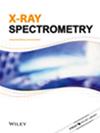Determination of trace elements in titanium oxides by wavelength dispersive x-ray fluorescence spectrometry (WD-XRF)
IF 1.5
4区 物理与天体物理
Q3 SPECTROSCOPY
引用次数: 0
Abstract
TiO2 is used in a great variety of industries (foods, medicines, cosmetics, etc.). In food industry, although the use of TiO2 as additive was banned by EU in 2022, it is still authorized in medicinal products, and is allowed as food ingredient in US and Canada. Focusing on cosmetics, regulations state some forbidden elements (As, Cd, Ni, Hg, Sb, and Pb), and others allowed with a specific limit (Co, Cr, and Se). Most researches about TiO2 characterization are focused on the purity determination and no studies analyzing trace metals in this material have been found. Due to the potential impact of those trace elements on health and safety, a robust method for determining them in TiO2 is required. A methodology for the determination of As, Cd, Co, Cr, Hg, Ni, Pb, Sb, and Se at trace level in TiO2 by WD-XRF has been developed. Sample was prepared as pressed pellets to achieve low limits required by regulations, and the best conditions were established using n-butyl methacrylate as binder and plastic spatula to avoid Cr contamination coming from the stainless-steel one. An in-depth inquiry conducted to get calibration and validation standards revealed a lack of reference materials; therefore, additions of pure oxides of each element were made to high-purity TiO2. Validation was performed by two means: analyzing synthetic standards prepared as stated and analyzing two commercial TiO2 by an independent method (ICP-OES). The developed methodology was suitable to be used as control method to assess whether the materials meet the regulations, since time required to undertake the analysis is much less than other methods.利用波长色散 X 射线荧光光谱法(WD-XRF)测定钛氧化物中的痕量元素
二氧化钛可用于多种行业(食品、药品、化妆品等)。在食品行业,虽然欧盟在 2022 年禁止将二氧化钛用作添加剂,但它仍被允许用于医药产品,在美国和加拿大也被允许用作食品成分。针对化妆品,法规规定了一些禁止使用的元素(砷、镉、镍、汞、锑和铅),以及其他允许使用但有特定限制的元素(钴、铬和硒)。有关二氧化钛特性的大多数研究都集中在纯度测定方面,尚未发现对这种材料中的痕量金属进行分析的研究。鉴于这些痕量元素对健康和安全的潜在影响,需要一种可靠的方法来测定二氧化钛中的这些元素。我们开发了一种利用 WD-XRF 测定二氧化钛中痕量 As、Cd、Co、Cr、Hg、Ni、Pb、Sb 和 Se 的方法。为了达到法规要求的低限值,样品以压制颗粒的形式制备,并使用甲基丙烯酸正丁酯作为粘合剂和塑料刮刀,以避免不锈钢刮刀污染铬。为获得校准和验证标准,进行了深入调查,发现缺乏参考材料;因此,在高纯度 TiO2 中添加了每种元素的纯氧化物。验证通过两种方法进行:分析如上所述制备的合成标准物质,以及通过独立方法(ICP-OES)分析两种商用二氧化钛。所开发的方法适合用作评估材料是否符合规定的控制方法,因为进行分析所需的时间远远少于其他方法。
本文章由计算机程序翻译,如有差异,请以英文原文为准。
求助全文
约1分钟内获得全文
求助全文
来源期刊

X-Ray Spectrometry
物理-光谱学
CiteScore
3.10
自引率
8.30%
发文量
38
审稿时长
6-12 weeks
期刊介绍:
X-Ray Spectrometry is devoted to the rapid publication of papers dealing with the theory and application of x-ray spectrometry using electron, x-ray photon, proton, γ and γ-x sources.
Covering advances in techniques, methods and equipment, this established journal provides the ideal platform for the discussion of more sophisticated X-ray analytical methods.
Both wavelength and energy dispersion systems are covered together with a range of data handling methods, from the most simple to very sophisticated software programs. Papers dealing with the application of x-ray spectrometric methods for structural analysis are also featured as well as applications papers covering a wide range of areas such as environmental analysis and monitoring, art and archaelogical studies, mineralogy, forensics, geology, surface science and materials analysis, biomedical and pharmaceutical applications.
 求助内容:
求助内容: 应助结果提醒方式:
应助结果提醒方式:


